Tope are right at the top of many UK kayak anglers wish list. This small species of shark provides incredible sport from a kayak and brings all the excitement and fear involved with catching a big fish with teeth. They are fairly easy to catch if present but location and timings can prove crucial in catching one.
Tope – small sharks on a kayak!
Tope (Galeorhinus galeus) are a species of shark that can be found across the UK. They can grow to over 80 lbs in weight and over six feet in length but such specimens are rare and fish in the 10-40 lb range are much more common. They have the classic shark shape with a mouth full of sharp teeth to match. These are powerful fish with a body full of muscle and as a result they give an awesome fight on rod and line. For most, they are the largest species of shark/fish that one is likely to catch from a kayak and they have an almost cult-like following amongst the kayak angling community!
Where and when to find tope
Tope tend to like deeper water with lots of tidal movement. Headlands and offshore reefs that see a good run of tide are often productive areas to target tope. Any areas or features that are known to hold lots of baitfish are well worth a try too. I like to fish water of at least 40 ft but tope can be found in waters of over 200 ft. Tope can be found all around the UK but seem to be more common on the south and west coasts. Popular regions that hold tope include North Cornwall, North Devon, South and West Wales, along with many other localised spots on the southern and eastern shores of the UK such as within the Solent and locations off the North Norfolk coast. Several spots in the northeast and in Scottish waters also hold tope however I’m not all that familiar with local hotspots in these areas. Local info is often key to finding specific tope holding marks and even when you know the venue you often need to know the exact reef or stretch these fish run and feed along to catch them. Time and effort on the water is usually the only way to unlock these secrets!
Tope are typically a summer species and tend to turn up from May and can be realistically targeted until October or November at most locations.
What gear do I need?
Tope are a powerful muscular fish and require a fairly pokey rod to keep an upper hand on them. I favour a 12-20 lb class boat rod, however you can use a 6-12 lb class rod if you want to put your gear to the limit and get maximum sport. A 6500-sized multiplier reel or 4,000 or 5,000 sized fixed spool loaded with 30 or 40 lb braid will happily cope with these fish.
I use 10ft of 40 lb monofilament leader attached to the braid with a modified Albright knot. The rig is essentially a running ledger that is beefed up. Use the weight on a zip slider with a bead to buffer this against a barrel swivel. The trace is then comprised of two components – a rubbing trace and a bite trace.
The rubbing trace consists of around 6 ft of 80 lb fluorocarbon or mono. This will resist abrasion against the rough skin of a tope, which will quickly wear through finer lines, especially if the fish wraps up/rolls up the traces as it twists and turns during the fight.
The bite trace consists of a swivel with 18-24 inches of 100 lb multi-strand wire leading to an 11/0 (or similar size) circle hook. The wire is attached to the swivel and hook via a Flemish loop that is double crimped and then covered in heat-shrink tubing to cover any sharp metal edges. Once assembled this ties onto the end of the rubbing trace. You don’t have to double crimp, or use a Flemish loop in the wire … but I like my rigs to be bombproof and I’ve never had a trace fail me. Some people prefer to use a 6 ft length of 150-200 lb mono for the trace but I have had fish bite through 150 lb mono and will no longer risk it, so a short length of wire is all I use.
Some people also use standard J-hooks, but by using circle hooks, you can all but ensure a 100% jaw or lip hook up so there is very rarely any deep hooked fish that you have to cut the trace on. A clean jaw hook up also makes life much easier when it comes to unhooking! Circle hooks are overall better for you and the fish.
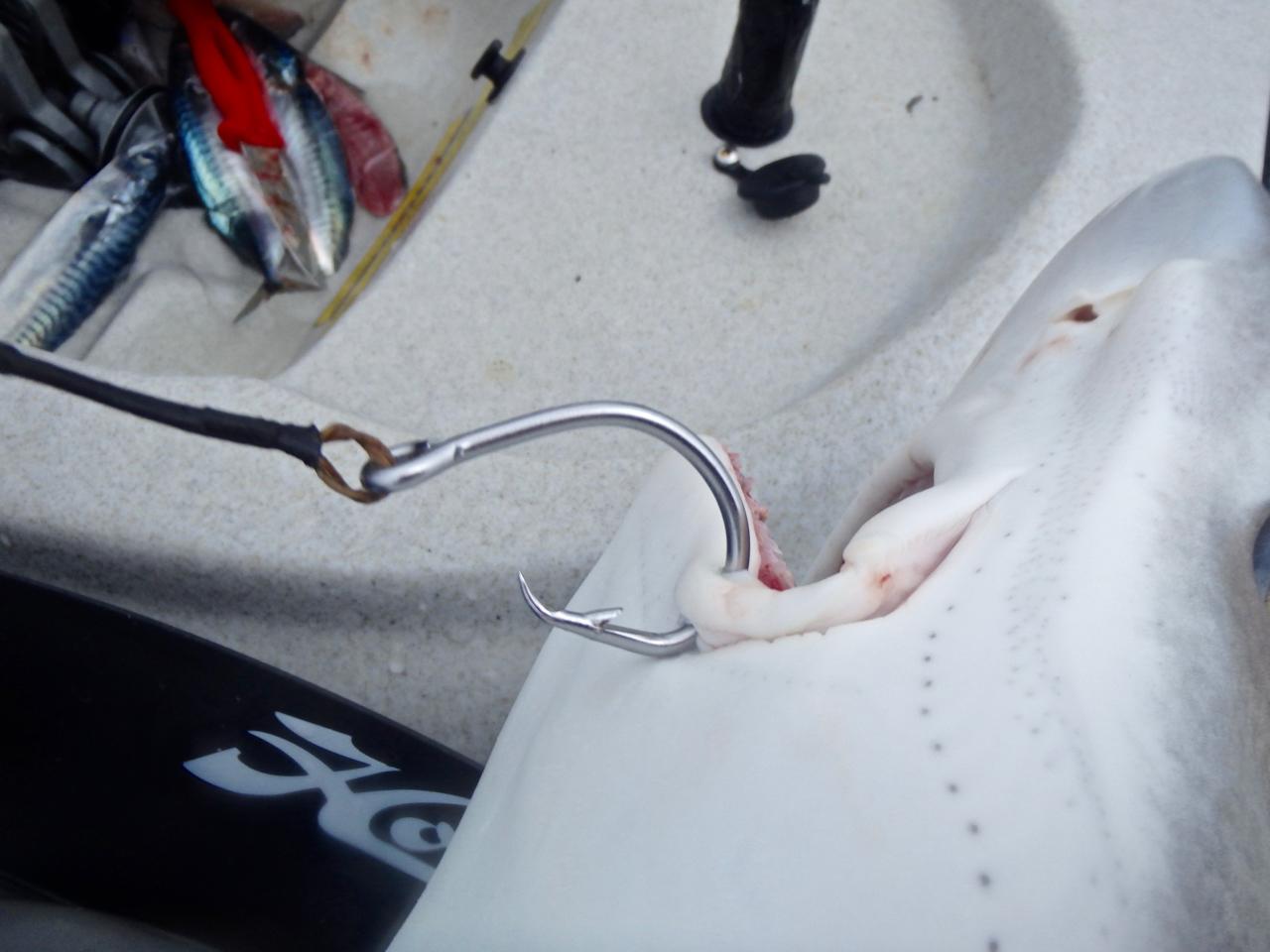
Circle hooks are designed to get a hook hold on the jawline/lips of the fish. This avoids deep hooking of the fish.
What bait?
Tope are towards the top of the food chain in UK waters and are active predators and also scavengers. Using their incredible sense of smell and good eyesight, they will chase and eat schooling baitfish such as mackerel, herring and lance in clear waters. In murkier waters or even darkness, Tope employ their ability to sense the tiny electrical impulses given off by prey, using special electro-receptors mainly located around their head and mouth. They can even locate flatfish buried in sand, which are quickly disturbed and eaten! Tope will also hunt and eat cephalopods such as squid and cuttlefish.
Any big fish baits will catch tope but my favourite is fresh mackerel, either fished as a flapper, or as a live-bait. Tope have big mouths so don’t be afraid to use big baits.
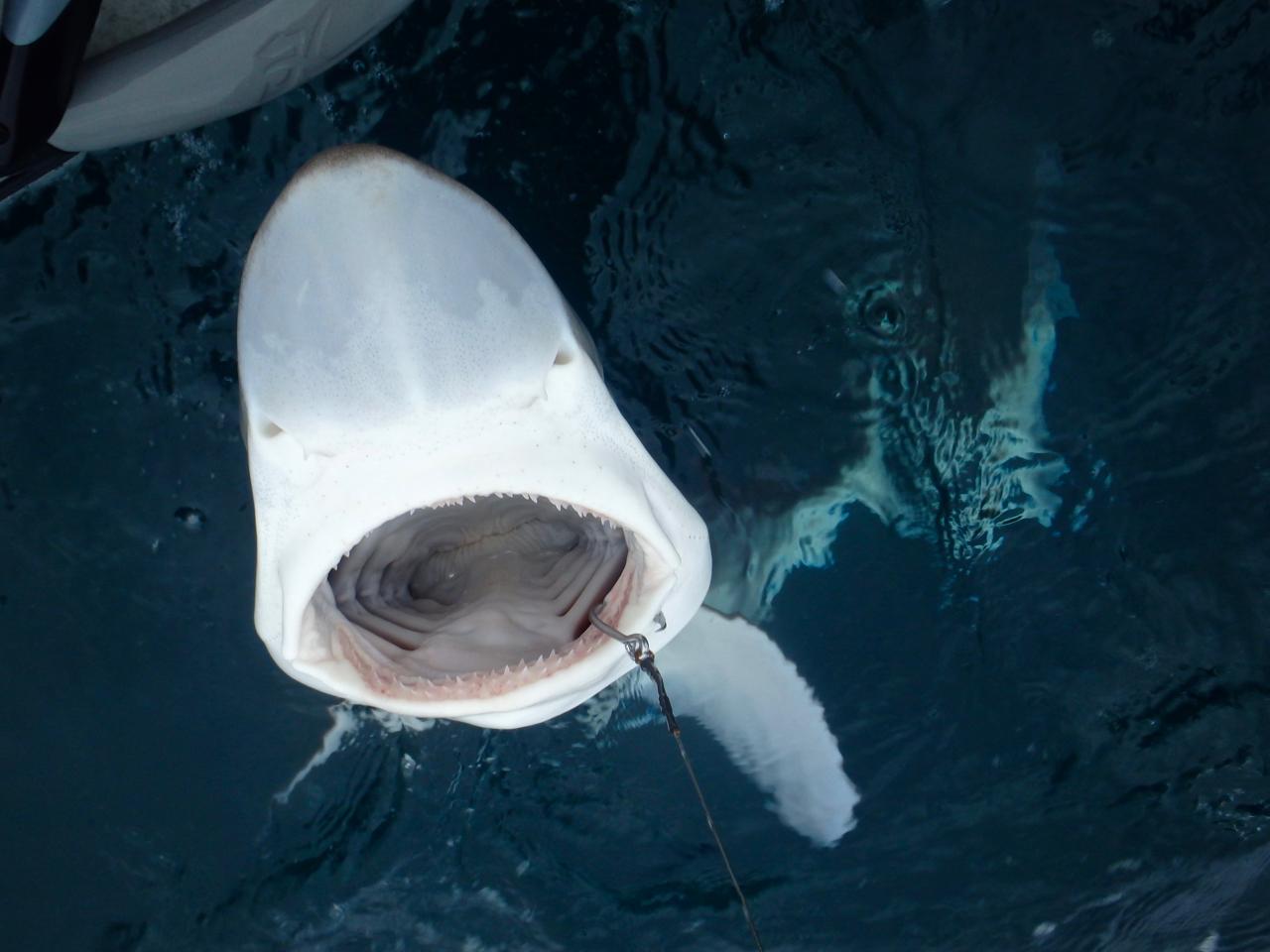
Tope have large mouths and will easily devour a whole mackerel bait
Half mackerel and mackerel fillets also work well too, especially if the fish are being finicky with larger baits. Big squid baits will also catch tope along with small flatfish, such as dabs or flounders, which are favoured by some anglers at some locations.
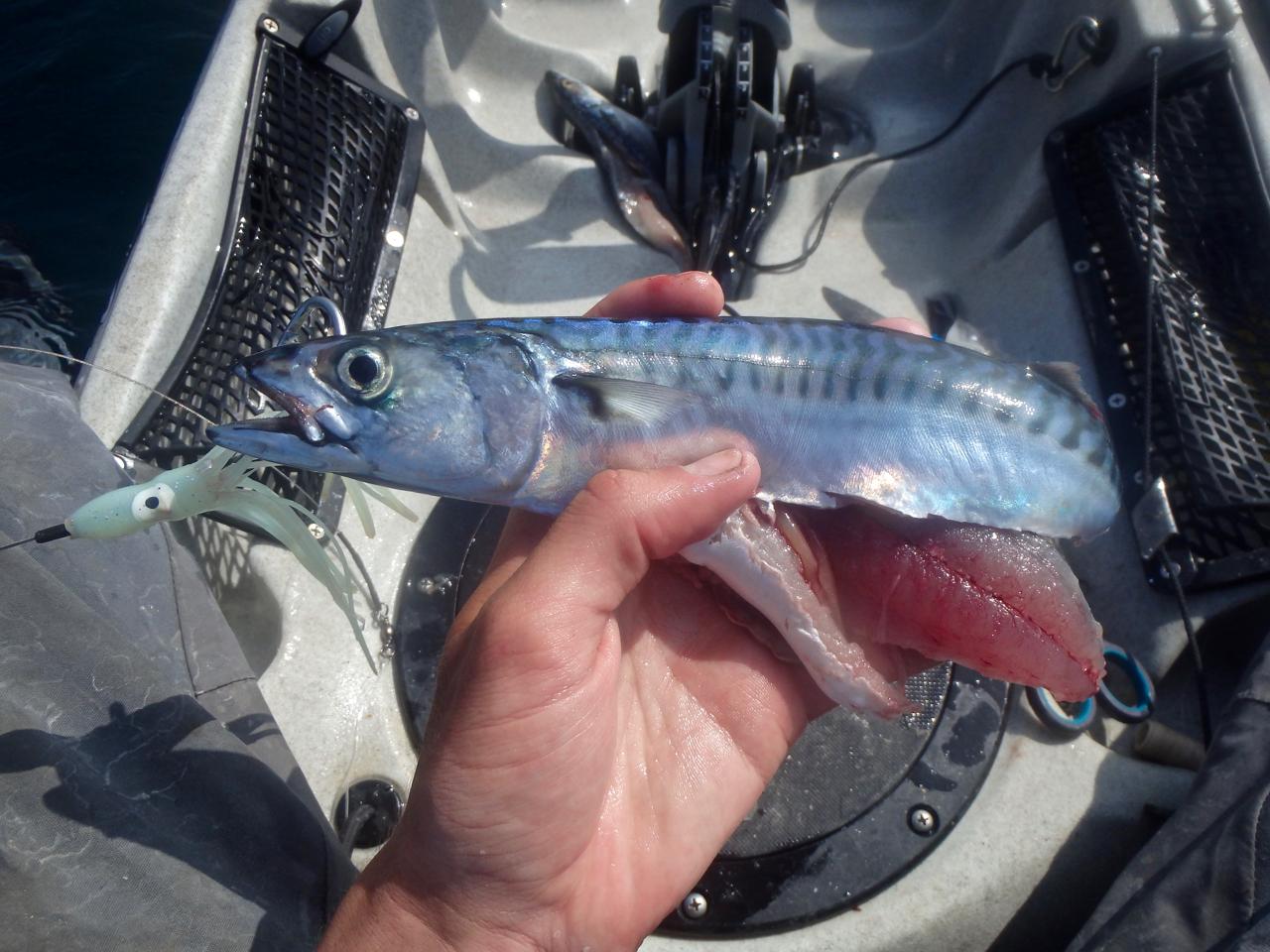
Not many tope can resist a fresh mackerel flapper bait
How to catch tope from a kayak
There are a few ways to target tope from a kayak. Tope tend to spend most of their time in the lower section of the water column, cruising over the bottom looking for prey, or grubbing around on the seabed itself. It is almost crucial to present a bait on or near the bottom to attract their attention.
Most anglers like to fish at anchor with a bait cast down-tide on the bottom, and this works well in areas of fast tidal flow. If there is low to moderate tidal flow you can get away with drift fishing, however if the ground is snaggy then expect to lose plenty of gear. Another option is to float fish, and this works quite well with live-baits if there are plenty of baitfish in the water column, as the tope will be up in the water chasing them.
I have always found tope fishing to be very hit and miss and also very dependant on baitfish being present. If there is little food around for the tope then chances are you won’t catch one. Some sessions I have drawn a blank or managed to winkle out a single fish, whereas other days I’ve caught over ten tope to one rod in an action packed session.
I tend to plan sessions to coincide with bigger tides and fish from low to high, or high to low if possible to ensure a good tide run – this is of course venue specific and some venues can only be fished at certain states of tide for safety reasons. Different venues see tope run at different states of the tide and it is very much a case of getting out there and giving it a go to see what works.
I’ve got a bite!
Tope will often take the bait with as much aggression as you’d expect from a shark. Exciting times! Sometimes you get a few warning nods as the fish attacks the bait and crams it into it’s mouth before powering off with it. Other times a run comes from out of the blue and the reel comes alive as line is pulled off the spool … and that brings us onto an important point … make sure your clutch is set so a fish can take line! Tope WILL run with the bait and will likely snap you up if you your clutch is set too tight. Let them run! Unless you know there are lots of snags where you need to apply lots of pressure to avoid a lost fish, then let the fish run off with the bait. A good tope will have no trouble peeling a hundred yards of braid from a reel before you can turn it.
Hooking a tope can sometimes be frustrating when fishing with big baits. They can just grab the end of the bait when they run and when you apply pressure to set the hook they will either let go or you will rip the bait from their teeth. Ideally you will have a proper bite/run and can set the hook successfully. If fishing with circle hooks, then apply steady pressure and the hook will set itself. There is no need to strike with circle hook and striking will actually decrease your chances of a hook up.
A fight with a tope can be exhilarating. Long powerful runs followed by hanging deep and resisting any attempts to tease the fish back to the kayak. Smaller fish may run you round for only a few minutes but bigger fish will have you in an arm wrenching tug of war for ten minutes or more. Even once coaxed to the kayak the fight will not be over. Expect one or two more powerful runs as the fish feels you grab the leader. Once beaten and lolling on the surface, it is time for the second half of the battle … bringing the tope on-board the kayak for unhooking.
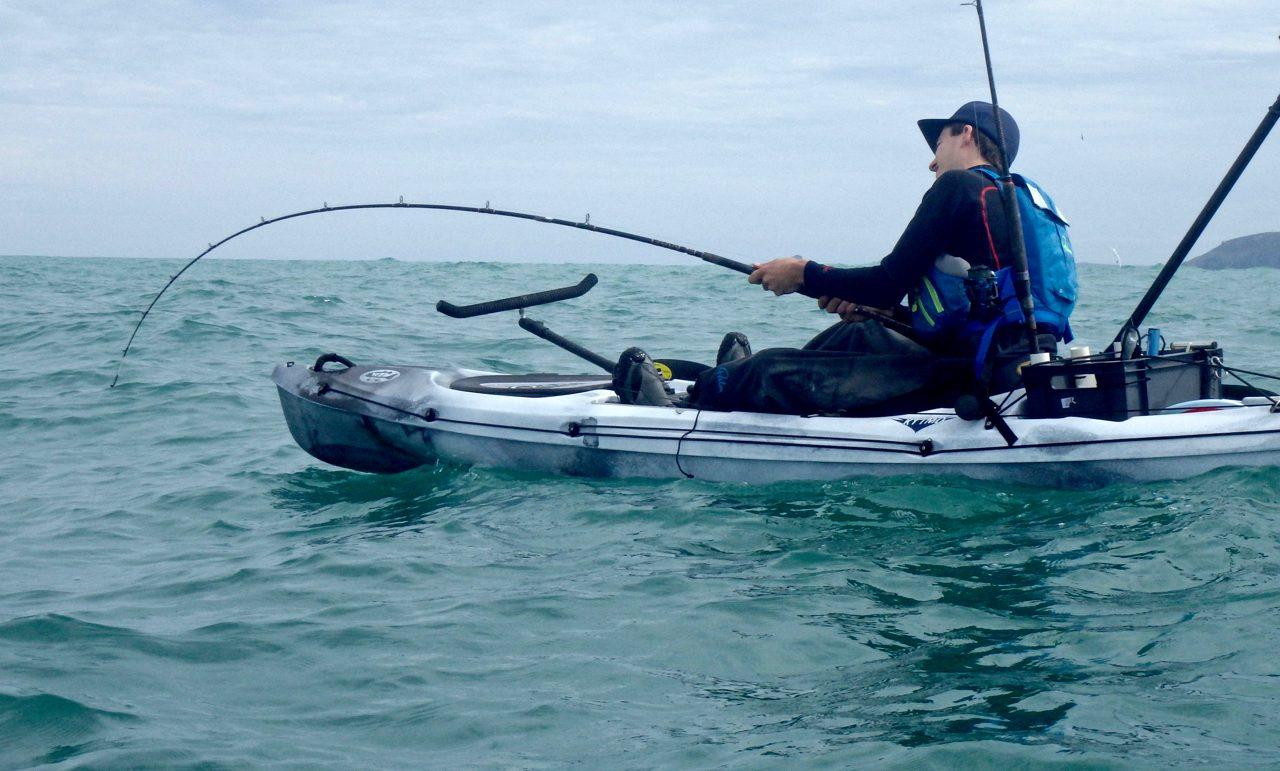
12-20 lb class gear is ideal for tackling tope from the kayak
Landing a tope on a kayak
This is the most dangerous part of tope fishing from a kayak. Sharp teeth, a powerful fish and limited room to move on a kayak is not the best recipe. Unless you are proficient with a T-bar disgorger (not many people are) and can unhook the fish in the water then it is a case of bringing the fish onto your lap for unhooking. Confidence is key and you must stay in control of the fish or risk meeting the sharp end of a tope … not recommended. There is little room for error with a shark on your lap.
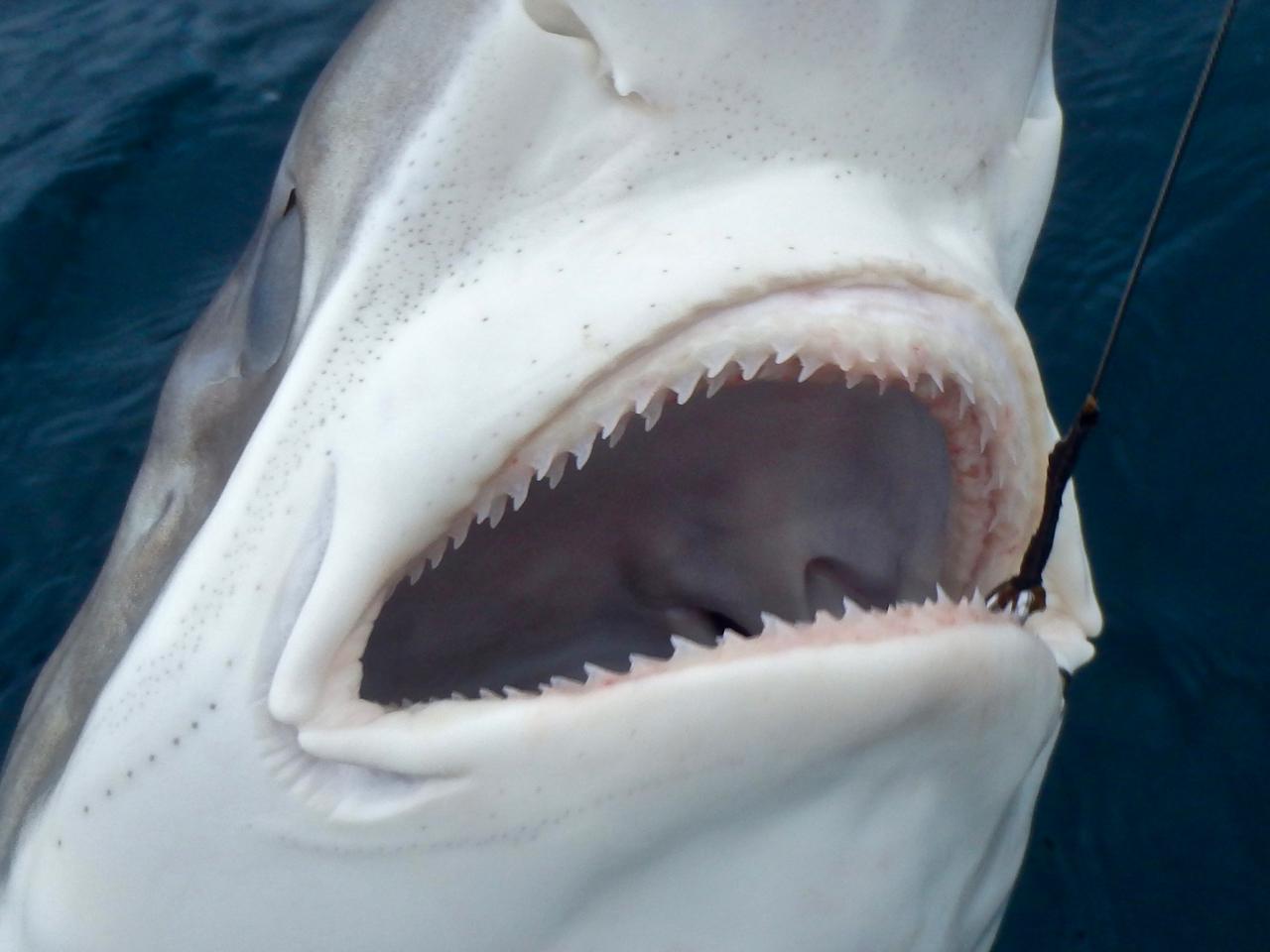
Tope have a fine set of teeth so be careful when handling!
Get a firm hold on the bite trace and get in control of the fish. Chances are it will be trashing around on the surface. You need to lift and drag the fish across your lap and position it’s head and mouth over the other side of the kayak and pin it down on your lap. In this position the tope can be offloaded back into the water should it get out of control. Be aware of your balance on your kayak as a fish thrashing around can easily unsteady you.
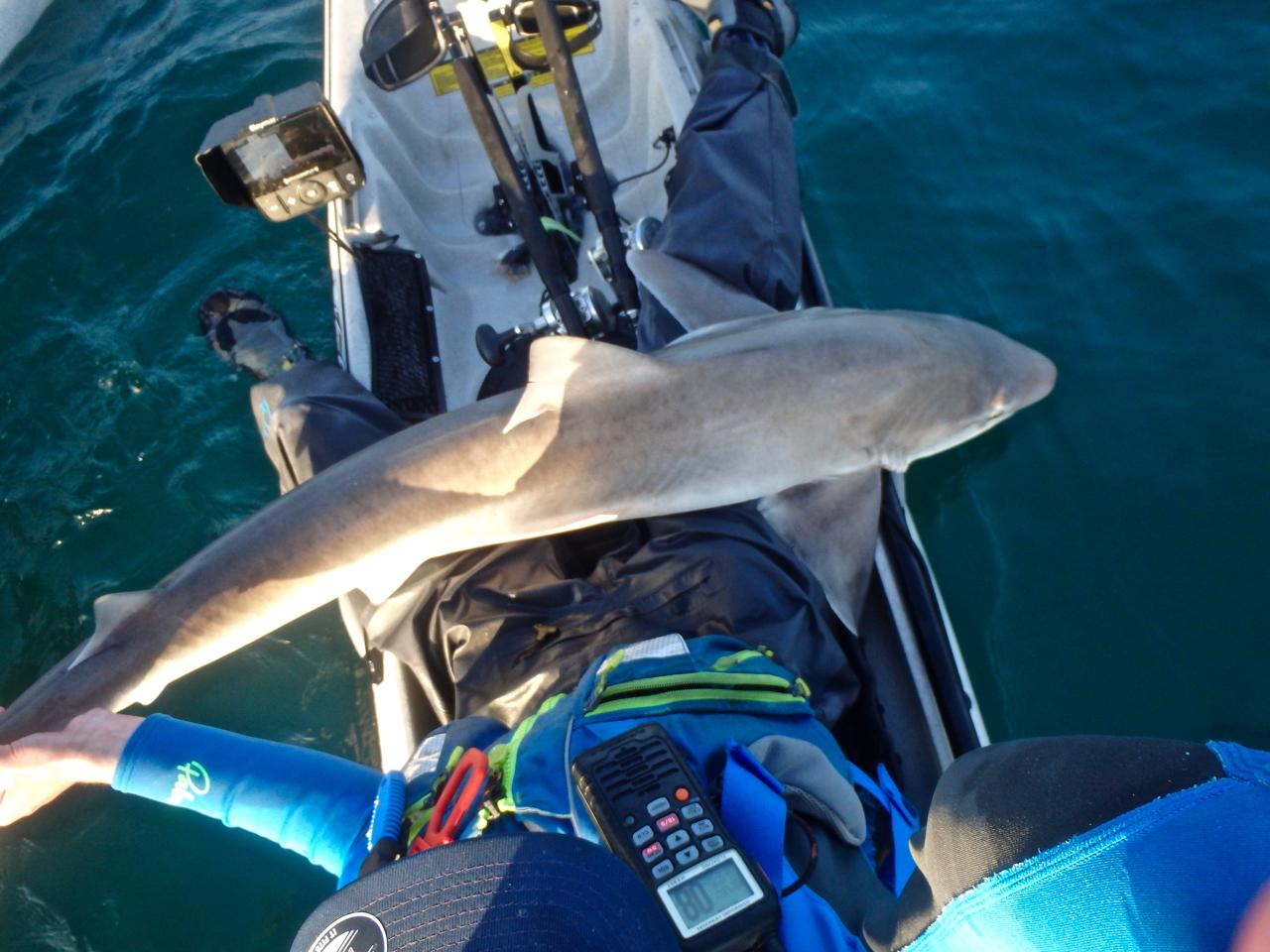
Lay a tope across your lap whilst unhooking with its mouth clear of your leg!
Once the fish has calmed you can unhook the fish. Have a pair of pliers handy to make unhooking easier and avoid putting your fingers/hand anywhere near it’s mouth. A T-bar disgorger is also handy to have to pull the hook out if pliers are not up to the job. Once unhooked the fish can be released. I like to hold the fish by the tail until it has regained strength to swim off. There is nothing better than seeing a tope power off back to the bottom! There is a great sense of achievement that comes with tope fishing and the release is definitely the cherry on the cake.
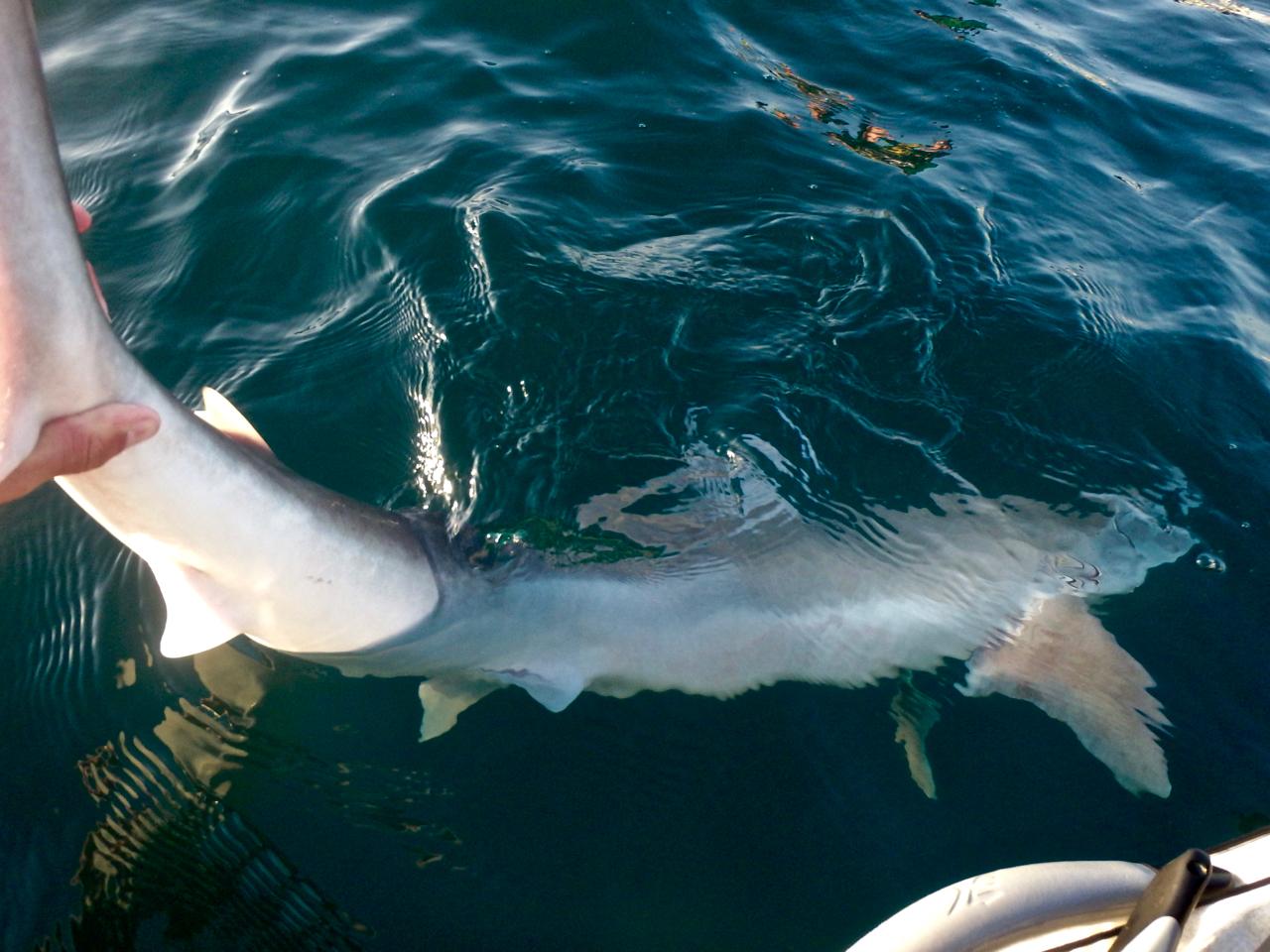
A tope ready for release beside the kayak
Tope fishing can be very frustrating at times but hit it right and you will have some of the best sport that UK kayak fishing can offer!
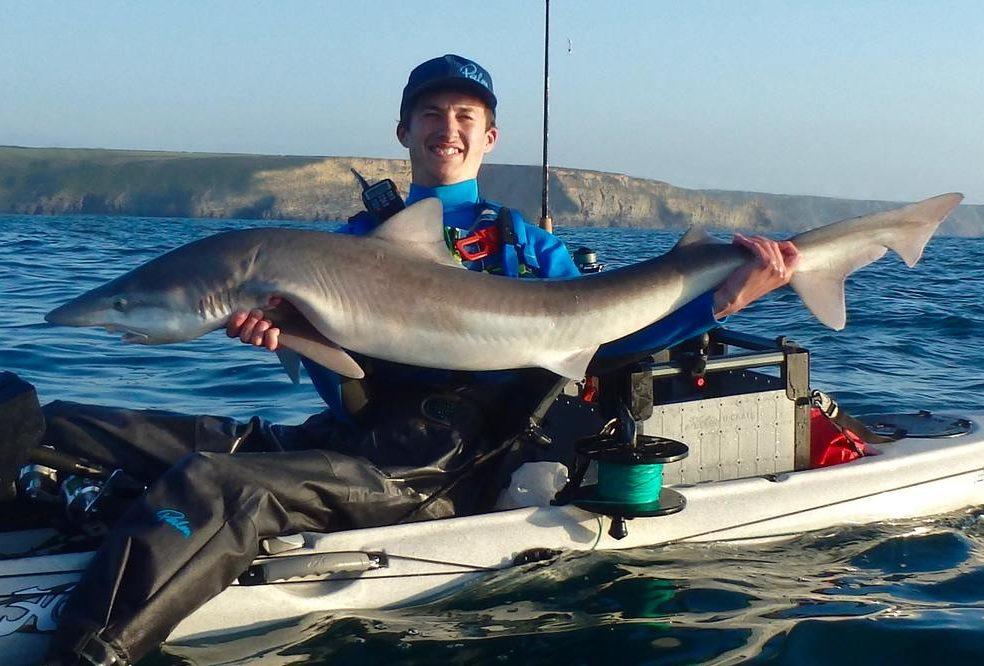
A 33 lb tope caught kayak fishing from the North Cornwall coastline